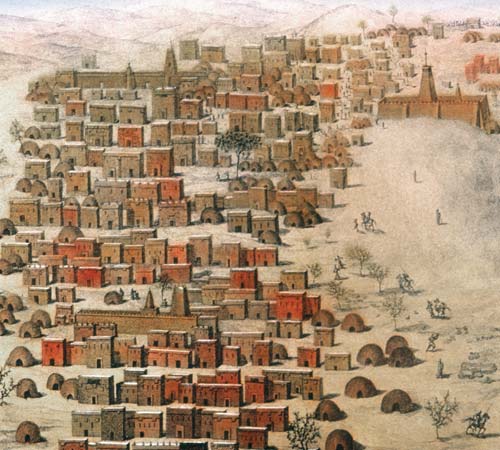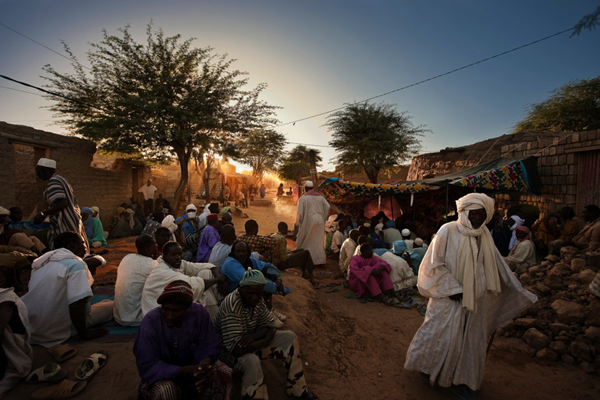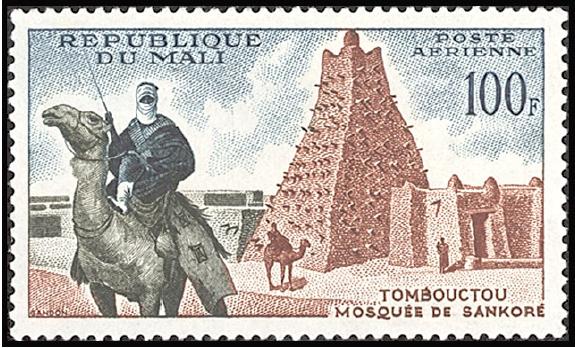
Ansar al Din rebels destroying the tomb of one of Timbuktu’s many Muslim saints, July 2, 2012. (Source: video still, USA Today).
by Alex Thurston
In northern Mali, an Islamist militia called Ansar al Din (Arabic: “Defenders of the Faith”) is fighting to implement its version of shari’a (Islamic law). The rebellion began with an uprising in January by the ostensibly secular National Movement for the Liberation of the Azawad (MNLA). The region quickly achieved de facto independence from the government in Bamako, but the MNLA has been politically outmaneuvered and at some points outfought by Ansar al Din.
The Islamists now control the city of Timbuktu and have attracted worldwide notoriety by destroying the shrines of local (Muslim!) saints. Why are they doing this? In an essay for The New Inquiry, novelist Teju Cole writes, “Their version of Islam — Salafist, fundamentalist — considers the syncretic practices of Malian Sufism, with its veneration of saints and incorporation of vernacular practices, haram [religiously forbidden].”
With the word “syncretic,” an idea that surfaces several times in his essay, Cole displays a set of political attitudes that are helpful neither for understanding the situation in Timbuktu, nor to those whose shrines are being destroyed. Cole is not alone in using this word to describe religious life in northern Mali. These depictions imply that “African Islam” is only pseudo-Islamic–different from, and less pure than, its Arab counterpart.
So what is meant by “syncretism”? According to Wikipedia, “Syncretism is the combining of different (often contradictory) beliefs, often while melding practices of various schools of thought.” When it comes to religion, one could argue that almost all practitioners are “syncretists”: Christians who have trees in their homes at Christmas, Buddhists who acknowledge a host of divinities, Hindus who incorporate Jesus as an avatar of Vishnu. One could also argue that most people who are widely labeled “syncretists” are believers who view their practices as part of a coherent and meaningful religious identity. Indeed, people who define themselves as syncretists, or people with explicitly plural religious identities, like “Jewish Buddhists,” are much rarer than people labeled “syncretists” by others. To call a believer a syncretist when she does not apply the label to herself verges on calling her a liar.

Illustration of Timbuktu by Rene Auguste Caille, reportedly the first European to return from a trip to Mali, 1832. (Source: Granger Collection, New York).
When it comes to Islam in Africa, the term syncretism has, historically, taken on unfortunate connotations. From the French colonial administration’s talk of Islam noir (“black Islam”) to the present, various observers have questioned the depth and integrity of black Africans’ commitment to Islam, often stating or implying that a Muslim identity was simply a thin veneer over the “animist” substrate beneath. A recent article on Mali speaks of the “Africanization of Islam” between the seventh and nineteenth centuries:
These pre-Islamic societies were characterized by a conception of the universe, the “weltanshauung” founded on animism, the force and presence of spirits, the possibility of a dialogue with the dead, hence the cult of ancestors, and the capacity to act on events thanks to supposedly “supernatural” powers possessed by certain members of the community (shamans or marabouts). Put together, all these elements would be incorporated into the acceptance of submitting to Islam whose faith is simple, clear, and solid.
Though written in 2012 by a Senegalese diplomat, this passage could have been written a hundred years ago by the French colonial administrator-scholars Maurice Delafosse (1870-1926) or Paul Marty (1882-1938).
The idea that there exists an “African Islam” suffused by “animism” sets up a number of unhelpful binary oppositions. Writers sometimes portray Arabs as the true Muslims and Africans as the “syncretists.” In this framing, “Arab Islam” is supposedly legalistic and puritanical, “African Islam” allegedly tolerant and pluralist. Delafosse, for example, wrote in 1912:
Whatever may be the number of our [West African] subjects converted to Islam and practicing the religion of Muhammad…it is very rare that the native Muslims have adopted [Qur’anic] law, at least in its entirety. In [Islam] proper, religion and law hold together, both deriving either from the [Qur’an] or from the hadith. But when people other than Arabs convert to the Muslim religion, be they in Asia, Europe or in Africa, they by no means always adopt the Muslim code which in many cases clashes with secular customs and a social or economic state at odds with the prescriptions of [Qur’anic] law [Quoted in Christopher Harrison, France and Islam in West Africa, p. 104].
The ultimate implication is that some Muslims are “more Muslim” than others and that in Africa there is such a thing as being “too Muslim,” the first warning sign of which is the desire to impose shari’a law.
The idea of a peaceful, syncretist “African Islam” that de-emphasizes law and embraces pluralism plays into notions of “good Muslims” and “bad Muslims.” As Mahmood Mamdani shows, conceptions of which sorts of Islamic identity are politically acceptable (to colonial administrations, to Washington, to the international community, etc) have varied over time. In West Africa a century ago, it was the Sufi orders that were seen as threats to the colonial order. Today, however, African Sufis are often depicted as representatives of the “right kind” of Islam, and as being a “bulwark against extremism.”
Timbuktu, 2012: history is not “repeating itself”
With regards to the complex situation in northern Mali, Cole suggests we can understand the destruction of the shrines by analogy, and he begins with the most obvious ones: Mali is premodern Europe; Mali is Afghanistan under the Taliban (a comparison heard more and more frequently these days, but successfully debunked by Andrew Lebovich here). Then comes the interesting analogy: Timbuktu is Mecca at the time of its conquest by the forces of the Prophet Muhammad. Mecca, the birthplace of Islam and its Prophet, had remained under control of a pagan elite while the Prophet established the Islamic state in Medina. When the Muslims reconquered Mecca, the Prophet ordered the destruction of its idols. This was the analogy Ansar al Din invoked to justify their actions in Timbuktu. Cole presents the comparison between Mecca and Timbuktu uncritically, but it suggests that in both cases Muslims were destroying the idols of non-Muslims. He writes:
In Timbuktu, a once wealthy trading city, in a place once fabled for its wealth and learning, now swallowed up by the Sahel, these mausolea are expressions of local practice: simple and old beliefs in a land of griots and marabouts, the kind of syncretism common to all the big world religions, owing as much to universal edicts as to what works for the people in their land, in their language, and according to their pre-conversion customs of veneration.
The problem with the comparison to Mecca, of course, is that in Timbuktu the shrines Ansar al Din destroyed were the shrines of Muslims, and those doing the destroying were fellow northern Malian Muslims. In trying to make the argument that the iconoclasts are in reality obsessed with icons, an obsession that represents a form of “love,” Cole ends up accepting part of Ansar al Din’s worldview: the Muslims of Timbuktu and their saints, Cole and Ansar al Din say, are only partly Muslim at best; their core is pagan. The difference between Cole and Ansar al Din, of course, lies in the value they attach to these acts of destruction.
To make a gross understatement, uncritical talk of “syncretism” insults the Muslims of Timbuktu and their heritage. Let’s start with Sufism: many Sufis would say that Sufism, including forms of Sufism that include veneration of saints, is not a departure from Islam or a survival of animism but rather constitutes the deepest essence of Islam. Sufis might say that the Prophet Muhammad and his Companions were Sufis, that the Qur’an extols the saints (see 10:62 and various interpretations of it), that saints provide links (in life and in death) between Muslims and Allah. The use of “marabout” by Cole, and the equivalence he suggests between it and “griot” (a non-Islamic term for storyteller), is revealing: “marabout” is not a word for pre-Islamic shamans or storytellers, but is rather a French colonial corruption of the Arabic word murabit, which derives from the root that means to link, bind, or connect – i.e., to Allah.
Then there’s the history: Timbuktu has been a Muslim city for at least eight hundred years. The city was home to famous Muslim scholars like Sheikh Ahmad Baba (d. 1627) and was a destination for scholars like Sheikh Muhammad ‘Abd al Karim al Maghili (d. 1505), whose intense concern with the application of Islamic law Ansar al Din might have a hard time matching. How long must a city be Muslim, and how much Muslim scholarship must it produce, before its Muslim credentials can be taken seriously? Or is it impossible that any place south of the Sahara can ever be fully Muslim, only “syncretist”? That anyone wishing to impose shari’a, to destroy shrines, to “purify” Islam, must be an outsider? That the resulting conflicts are not intra-Muslim, but Muslim outsiders versus local syncretists?
If so, then Ansar al Din has won the religious debate over shrines, while Muslims with alternative viewpoints have lost the political debate over the role of Islam in the modern world. If “real Islam” can only be defined as puritanical, legalistic, and violent, then “real Islam” can be equated with “bad Islam,” and the only “good Muslims” will be those whose Islam the West views as partial and insincere. Cole’s explanation of Ansar al Din’s destruction of shrines in Timbuktu is reminiscent of those who say, “Islam makes no separation between religion and politics” in one breath, and in the next demand that “moderate Muslims” step forth to disavow any connection between Islam and politics. Is there no way to be a “moderate” and a “real Muslim” at the same time?
The alternative – and the greatest challenge to Ansar al Din’s program – is not to assert Islamists’ hidden love for the things they say they hate, but to assert the reality, the desirability, and the possibility that there is more than one way to be a real Muslim. Timbuktu in 2012 is not Mecca in 630. African Muslims are Muslims, full stop. And the loss of shrines in Timbuktu is a loss not only for world civilization and for locals, but also for Islam.
Alex Thurston is a Ph.D. candidate in Religious Studies at Northwestern University. For 2011-2012, he is conducting dissertation fieldwork in Northern Nigeria. Alex has written for the Christian Science Monitor, Foreign Policy, and The Guardian. He blogs at http://sahelblog.wordpress.com, and is a regular contributor to The Revealer.


